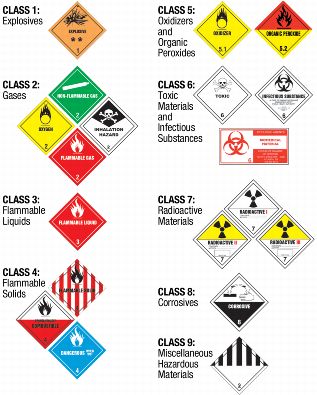The Department of Transportation has the responsibility of making sure that all materials shipped are done so according to strict standards, especially when it comes to the shipment of biological and hazardous materials. To abide by the regulations for shipment of hazardous materials, there are seven steps to follow when preparing these types of materials for transport. The steps are:
1- Classify the material and name it
2- Properly package the material
3- Mark the parcel with pertinent information
4- Label it with the proper safety information
5- Complete and attach the necessary paperwork (cradle to grave)
6- Place the proper placards and stamps on the package
7- Place the material in the proper transport vehicle and place the same placards on the vehicle
In step 1, according to the data sheet for TBL, you would classify it as a "pyrophoric, liquid, water reactive, organometallic substance." You would also put the UN number 3394 and reference #'s 4.2 and 4.3 on the name and information label and sheet that you will later include in the package.
As for packaging, since the substance is 25 mL, you can use a waterproof sealed 125 mL test tube labeled with the name and UN number of TBL. Then, the test tube would be placed inside an airtight casing to protect it further and place that with some form of foam or padded insulation in a rigid cardboard box.
The box before it is closed will have a hazardous substance manifest included in it, and the SDS sheet for TBL along with the manufacturers paperwork including the name, toxicity, and hazardous information as well as emergency contact information that is direct from the manufacturer.
The parcel will then be marked with the labels for corrosive and reactive materials using the numbers 4.2 and 4.3 on the package. The labels will be placed within 6 inches of each other and not cover up any other markings on the package. The package will also be marked with the name of the material along with the labels "Dangerous When Wet" and "Spontaneously Combustible" in clear, easily noticed lettering on the front of the package, but not covering any other markings.
At this point, the paperwork is mostly duplicates of what is already done for the internal packaging, but the attached paperwork must be placed in a waterproof sleeve on the package. It must include the name, UN number, hazard class, quantity, destination, name, and emergency contact information. This is for responders who need to know what exactly to do with the material in the event of an accident or other misstep that can cause a reasonable leak within the package.
The last step involves perparing the shipment vehicle, and since TBL is not permitted to be shipped via plane, it must be shipped by ground, or sea. I choose to ship this by ground via railway because I am shipping it to Hartford, CT. For this method, I must change the placards on the train car to mimic the ones on the package. The placards will show the UN number of TBL (3394) and the hazard class of 4.2 and 4.3.
By following all of these instructions, I can say that I will be able to safely and legally transport 25mL of tert-butyllithium to Hartford, CT from Athens, OH. If it takes 2 days to arrive in CT i can expect that if the train is kept at 15 degrees celsius, that 24.995 mL of true TBL will arrive due to its decomposition rate of 0.02% weight per day at 15 degrees C.
http://www.fmclithium.com/Portals/FMCLithium/content/docs/DataSheet/QS-PDS-044%20r2.pdf
http://131.104.156.23/lectures/7113/7113_Literature/FMC%20Lithium%20pdf/FMC_ButylCat_web.pdf
https://www.fmcsa.dot.gov/regulations/hazardous-materials/how-comply-federal-hazardous-materials-regulations
